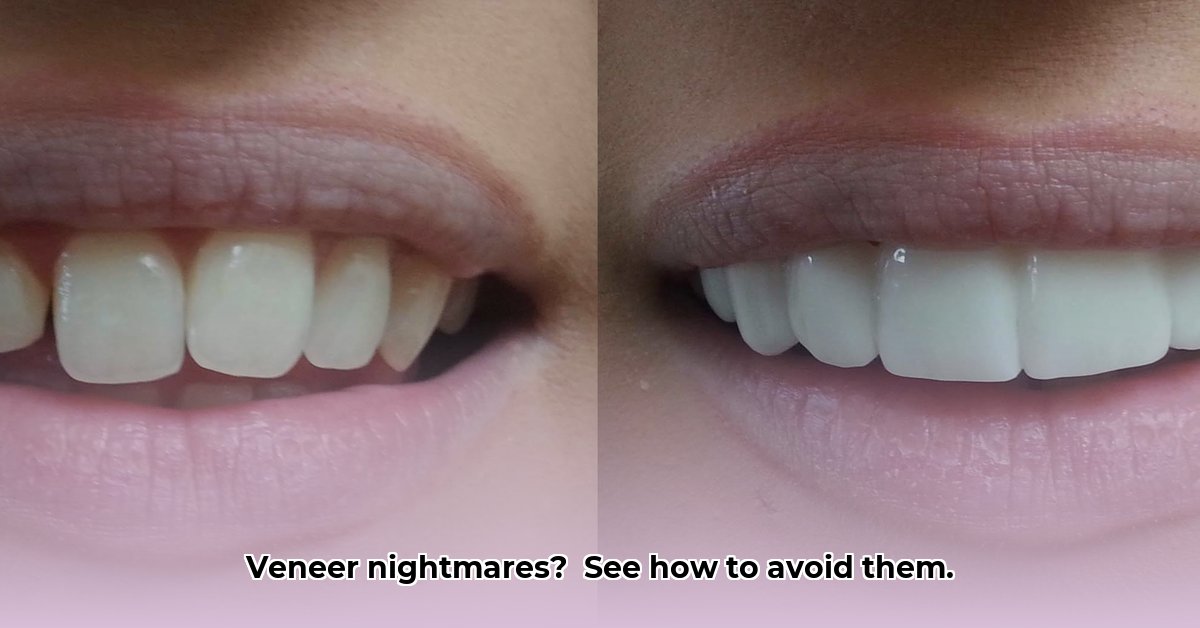Dreaming of a perfect smile? Veneers might seem like the quick fix, but beware – they can go wrong. This comprehensive guide explores potential “veneer nightmares,” offering crucial advice on choosing the right dentist and understanding the procedure to achieve the smile you actually want.
Veneer Nightmares: When Dreams Turn into Disasters
Veneers promise a flawless smile, but sometimes, the reality is far from perfect. This section reveals what can go wrong, complete with visual examples.
Gallery of Regret: Veneers Gone Wrong
(Insert high-quality before & after images/short video clips showcasing veneer complications: bulky sizes, unnatural colors, gum recession, chipping, uneven edges, discoloration. Captions should explain the issue: “Overly large veneers created an unnatural ‘horse teeth’ look,” “Poor color match creates a jarring contrast with natural teeth,” “Gum recession exposes sensitive root surfaces.”)
These images highlight the importance of careful planning and choosing a skilled cosmetic dentist. Veneers can create stunning transformations, but they’re not a guaranteed fix and require expertise to achieve natural-looking results.
Why Veneers Fail: Unmasking the Culprits
Several factors contribute to veneer failures. An inexperienced dentist may lack the artistic eye and technical skill for optimal results. Poor planning and communication can lead to mismatched expectations and veneers that don’t complement your facial features. Subpar materials are more likely to chip, crack, or discolor. Finally, neglecting underlying dental issues before veneer placement can jeopardize long-term success.
Choosing the Right Cosmetic Dentist: Your Step-by-Step Guide
Finding a qualified cosmetic dentist dramatically increases your chances of a successful outcome.
-
Credentials Check: Verify board certification in cosmetic dentistry and membership in reputable organizations like the American Academy of Cosmetic Dentistry. This suggests a commitment to advanced training and ethical practices.
-
Portfolio Scrutiny: Review before-and-after photos of their patients. Assess the naturalness of the results, the harmony with the patient’s features, and the overall aesthetic.
-
Consultations are Crucial: Meet with several dentists to compare approaches, ask questions, and gauge their communication style. Inquire about their experience with different veneer types, utilization of Digital Smile Design, and approach to complication management.
-
Spotting Red Flags: Avoid dentists who overpromise, pressure you into quick decisions, or lack transparency about costs and procedures. Cautious language and realistic expectations are crucial.
-
Trust Your Instincts: If something feels off, trust your gut and seek another opinion.
Understanding the Veneer Procedure: Managing Expectations
Veneers involve removing a thin layer of enamel, taking impressions, and bonding custom-made shells to your teeth. It’s a multi-stage process that requires time and precision. Temporary veneers may be worn while the permanent ones are fabricated.
Understanding Potential Risks and Complications: Facing the Facts
While generally safe, veneers carry potential risks: chipping, cracking, increased tooth sensitivity, and, less frequently, infection. Your dentist should discuss these possibilities openly. Ongoing research continually explores new techniques and materials to minimize these risks.
Fixing Bad Veneers: The Road to Recovery
Corrective options for unsatisfactory veneers include repairs, adjustments, replacements, or even removal and exploring alternatives. Costs vary significantly depending on the complexity of the issue. Options like Face Lift Dentistry® for extensive corrections can be particularly expensive.
Exploring Alternatives to Veneers: Other Paths to a Perfect Smile
Depending on your needs and goals, alternatives like bonding, crowns, teeth whitening, or orthodontics might be suitable. A qualified dentist can guide you toward the best option.
Long-Term Veneer Care: Protecting Your Investment
Maintain your veneers with regular brushing, flossing, and dental checkups. Avoid hard foods and habits that could damage them. Proper care maximizes their lifespan and preserves their appearance. Potential additional future developments in the field may increase the lifespan, longevity, and other long-term issues.
Frequently Asked Questions (FAQ)
| Question | Answer |
|---|---|
| How long do veneers usually last? | With proper care, veneers can last 10-15 years, and sometimes longer. |
| Is the veneer procedure painful? | A local anesthetic typically minimizes discomfort during the procedure. Some patients may experience mild sensitivity afterward. |
| How much do veneers typically cost? | Costs vary depending on several factors, including material, number of veneers, and the dentist’s fees. Get a detailed quote during your consultation. |
| Can I whiten my veneers? | No, traditional whitening methods don’t work on veneers. They are stain-resistant but maintain their initial shade. |
Conclusion: Making Informed Decisions for a Confident Smile
Choosing veneers is a significant decision. Thorough research, selecting a qualified dentist, and understanding the process, risks, and alternatives are essential. This empowers you to avoid “veneer nightmares” and achieve the healthy, beautiful smile you desire. Consult a local dental professional for personalized guidance.
- Shop Bento Lunch Boxes on Sale Nearby Now - December 7, 2025
- Shop Bento Box for Sale To Find Your Ideal Lunch Container - December 6, 2025
- Lunch Box That Fits Bento Box Neatly for Daily Use - December 5, 2025










